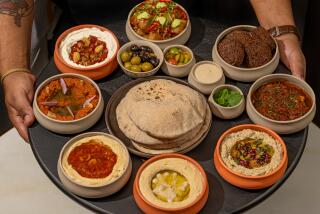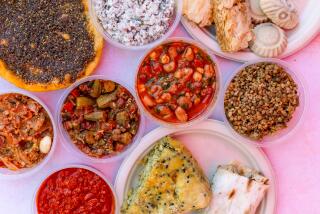Off the shelf: The essential Persian cooking staple you probably don’t have
Shuffle the pages of Najmieh Batmanglij’s massive cookbook “Cooking in Iran: Regional Recipes and Kitchen Secrets” — a 700-plus-page compendium of the cuisine of Iran that she has mastered over the last three decades — and you’ll find certain ingredients dropped like trail markers.
Her spice route is scattered with rose petals and cardamom pods, barberries like handfuls of garnets and obsidian-black nigella seeds. But one ingredient infiltrates the pages and perfumes many of the dishes: the dried limes, whether whole or powdered, that have long been a staple of Persian cooking, yet remain mysteriously unappreciated to a broader range of cooks.
Pass them on the shelf of a Middle Eastern market and they look like a forgetful grocer’s mistake — large nut-brown pebbles, dusty and desiccated, shrunken citrus skulls. But whack them with a hammer, and you’ll find a glossy interior the color of mahogany, and a sudden, magnificent fragrance that’s both bright and funky, the acidic twang of limes distilled to their essence.
Dried lime has “a tangy, earthy taste that gives a special, very distinctive flavor to the dish that fresh lime juice doesn’t,” said Batmanglij recently when I called her at her home in Georgetown, where she’s lived for a quarter of a century, since fleeing revolutionary Iran, first for France in 1979, and then to the U.S.
“This is a very ancient method. In Iraq they use it; in Middle Eastern cultures. In Iran they call it limu Omani,” she says, from that country on the other side of the Persian Gulf from Iran, where many dried limes are produced. “Loomi in Iraq and Oman. I’ve seen white dried limes in China. There was a lot of interaction because of the Silk Road: They transferred not only literature and art, but also ingredients.”
(Batmanglij’s latest book reads like a Lonely Planet guide written by Herodotus but, for those inclined to go even deeper on the subject of Iranian cooking, her recently republished 1986 masterwork “Food of Life: Ancient Persian and Modern and Iranian Cooking and Ceremonies” is a must.)
Batmanglij dusts recipe after recipe with powdered dried lime, zapping a three-day marinade for chicken kebabs with a huge dose of the stuff, then sifting it over the finished dish like a potent benediction. Fish kebabs are also spiked with the powder, and a dish of spiced rice with pan-seared fish is cooked with a broth steeped with dried limes. They dose poached lobster and permeate a street food snack of sauced potatoes on flatbread. Whole limes jack the flavor of a braise of lamb, beans and herbs, and are made into a tea by simmering them with rock candy.
“Dried lime tea, you make it and combine it with valerian; it’s a fantastic nightcap,” said Batmanglij, who has an apothecary’s worth of jars filled with the limes in her kitchen. “You can make shrub with dried limes. Chicken soup.”
Like the squeeze of fresh lemon that many cooks use to brighten dishes, a whole dried lime or dash of the pulverized stuff elevates the flavor of soups and stews, braises or, really, almost anything.
At Sqirl, Jessica Koslow’s progressive toast restaurant in East Hollywood, she adds dried limes to her addictive chicken porridge. “We use almost a cup of dried lime powder in every batch we make,” says Koslow. “It’s a play on the Omani dish madrouba, which is typically quite dense; somehow it works. Hugh Acheson came to Sqirl, and the first time he had it, he was shocked: ‘Jessica, do you know you’re feeding chicken and rice soup to people for breakfast?’ Yes, yes I do.”
And at Adana in Glendale, a restaurant that combines the cooking of Armenia, Iran, Turkey and Georgia, whole dried limes are dropped into both of chef-owner Edward Khechemyan’s stews, khoresh ghormeh sabzi and khoresh bademjan. (Both restaurants are on The Times’ 101 Restaurants We Love list.)
Anissa Helou, whose “Feast: Food of the Islamic World” — also the product of years of research— came out last year as well, emailed with a few more suggestions for what to do with dried limes. “They are used whole in dishes such as marguga (what I like to call Arabian ‘pasta’ with meat and vegetables), and the pulp is used in dishes such as mashkhul, a beautiful saffron rice dish layered with chicken and vegetables and garnished with toasted almonds and caramelized onions. In Saudi Arabia, dried limes are ground and used in mashbuss rubyan, a kind of shrimp ‘risotto.’ ”
Feasting and fasting: The meaning of the rituals of Ramadan »
Unsurprisingly, Batmanglij suggests you grind your own limes, as the flavor of the powdered stuff you can find in markets deteriorates over time, and often the commercial product is ground with the seeds, which makes it a little bitter. (“Some people like that bitterness,” she notes.) Break up the whole limes, pry out the seeds — you can also remove the peel and use only the hearts of the fruit — and grind the shards in a spice grinder. “You can make it grainy or you can make it powder; I have both.”
Equally unsurprising, she also suggests making your own dried limes. “It’s quite easy. You macerate them first with salt, then the next day you parboil them and drain them twice, with water and vinegar. Then you allow them to sun-dry; you can even dry them in the oven or dehydrate them. It takes 13 or 14 days.”
Given their versatility, range and ability to add nuance to a vast catalog of dishes, dried limes are worth the effort, if not to make yourself, then to source. The Los Angeles-based company Sadaf carries them (it’s where Koslow gets hers, wholesale), both whole and powdered, as well as black dried limes. “In Iran when I interview people, they say the black one is aged more,” says Batmanglij. “Other people say they’re a different kind of lime.“ As for which to use, her guideline is to use the black dried limes for dishes utilizing green herbs, the brown version for tomato-based dishes. Another tip? Pierce the whole limes first, if you’re tossing them intact into a dish or pot.
Dried limes may look like something out of an Old World alchemist’s shop, if not a botanist’s dust bin, but they have a transformative property that fits the reference. At once floral and astringent, musky and sour, think of the stuff as pantry shelf pixie dust.
Chicken Kebab With Dried Lime and Mint
1 hour, 10 minutes plus overnight marinating. Serves 6 to 8
Ingredients
- ¾ cup olive oil
- ½ cup fresh lime juice, plus the juice of 1 lime
- ½ cup apple cider vinegar
- ¼ cup ground hearts of dried Persian limes
- 2 tablespoons dried mint
- 1 tablespoon crushed red chile flakes
- 4 teaspoons fine sea salt
- 2 teaspoons freshly ground black pepper
- 2 teaspoons ground green cardamom
- 1 teaspoon ground turmeric
- 1 medium yellow onion, coarsely sliced
- 6 garlic cloves, peeled and thinly sliced
- 1 (4-pound) whole chicken, cut into 10 pieces, or 2 ½ pounds boneless chicken thighs, cut into 3-by-2-inch pieces
- 2 cups chopped fresh mint (or ¼ cup dried mint)
- ½ cup (8 tablespoons) unsalted butter or vegetable oil
- 1 package (12 ounces) lavash bread
- 3 bunches fresh basil leaves
Instructions
- In a large storage container or gallon-size ziptop plastic bag, combine the olive oil, half-cup lime juice, the cider vinegar, 3 tablespoons ground dried lime, the dried mint, chile flakes, salt, pepper, cardamon, turmeric, onion and garlic. Add the chicken and toss well to coat it in the marinade. Cover and refrigerate overnight and up to 3 days, turning the chicken twice while it marinates.
- Prepare a charcoal grill for direct grilling, heat a gas grill to high or heat your broiler to high. (The success of a good kebab depends on a very hot grill.)
- Using 12 flat, half-inch-wide sword-like metal skewers or 10 to 15 wooden skewers (soak wooden skewers in water for 5 to 10 minutes before skewering to prevent burning), skewer the wings, breasts and legs onto different skewers (they will require different cooking times). Place the skewers on a baking sheet or platter.
- Prepare the baste: In a small saucepan, heat the remaining juice of 1 lime, the fresh (or quarter-cup dried) mint and butter over low heat to marry the flavors. Remove from heat and hold in a warm place.
- Grill the chicken pieces, turning frequently and basting often with the mint butter, until done, 8 to 15 minutes depending on size. The chicken is done when the juice that runs out is yellow rather than pink.
- Arrange the lavash evenly on a flat serving platter. Remove the chicken from the grill and place on the bread. Keep the chicken on the skewers until just before serving to help keep it warm.
- To remove the chicken from the skewers, steady them on the platter with a piece of bread and pull out the skewers. Sprinkle the remaining 1 tablespoon ground dried lime over the chicken and garnish with the basil.
Note: Adapted from a recipe in “Cooking in Iran: Regional Recipes and Kitchen Secrets” by Najmieh Batmanglij.
More to Read
Eat your way across L.A.
Get our weekly Tasting Notes newsletter for reviews, news and more.
You may occasionally receive promotional content from the Los Angeles Times.
![LOS ANGELES, CA - JUNE 17: [Cody Ma and Misha Sesar share a few dishes from their Persian Restaurant Azizam] on Monday, June 17, 2024 in Los Angeles, CA. (Ethan Benavidez / For The Times)](https://ca-times.brightspotcdn.com/dims4/default/7ffc7f6/2147483647/strip/true/crop/5110x3417+306+0/resize/320x214!/quality/75/?url=https%3A%2F%2Fcalifornia-times-brightspot.s3.amazonaws.com%2F79%2Fdc%2F4d29255545f5b9813315901692bc%2F1459972-fo-azizam-review20-eba.JPG)










